Commercial Law: Negligence and Misrepresentation Case Study Analysis
VerifiedAdded on 2023/06/08
|8
|2104
|456
Essay
AI Summary
This essay provides a comprehensive analysis of negligence and misrepresentation in commercial law. It examines two problem questions involving scenarios of potential negligence and misrepresentation, applying relevant legal principles and case law to determine liability and available remedies. The first question addresses a rugby player's injury due to a dangerous tackle, analyzing duty of care, breach of duty, and vicarious liability. The second question concerns economic loss suffered by investors based on negligent financial advice, exploring the concept of negligent misrepresentation and the potential for recovery of damages. The essay concludes with a determination of liability and potential legal recourse for the parties involved, supported by relevant legal citations and a bibliography. Desklib provides this assignment as a resource for students.
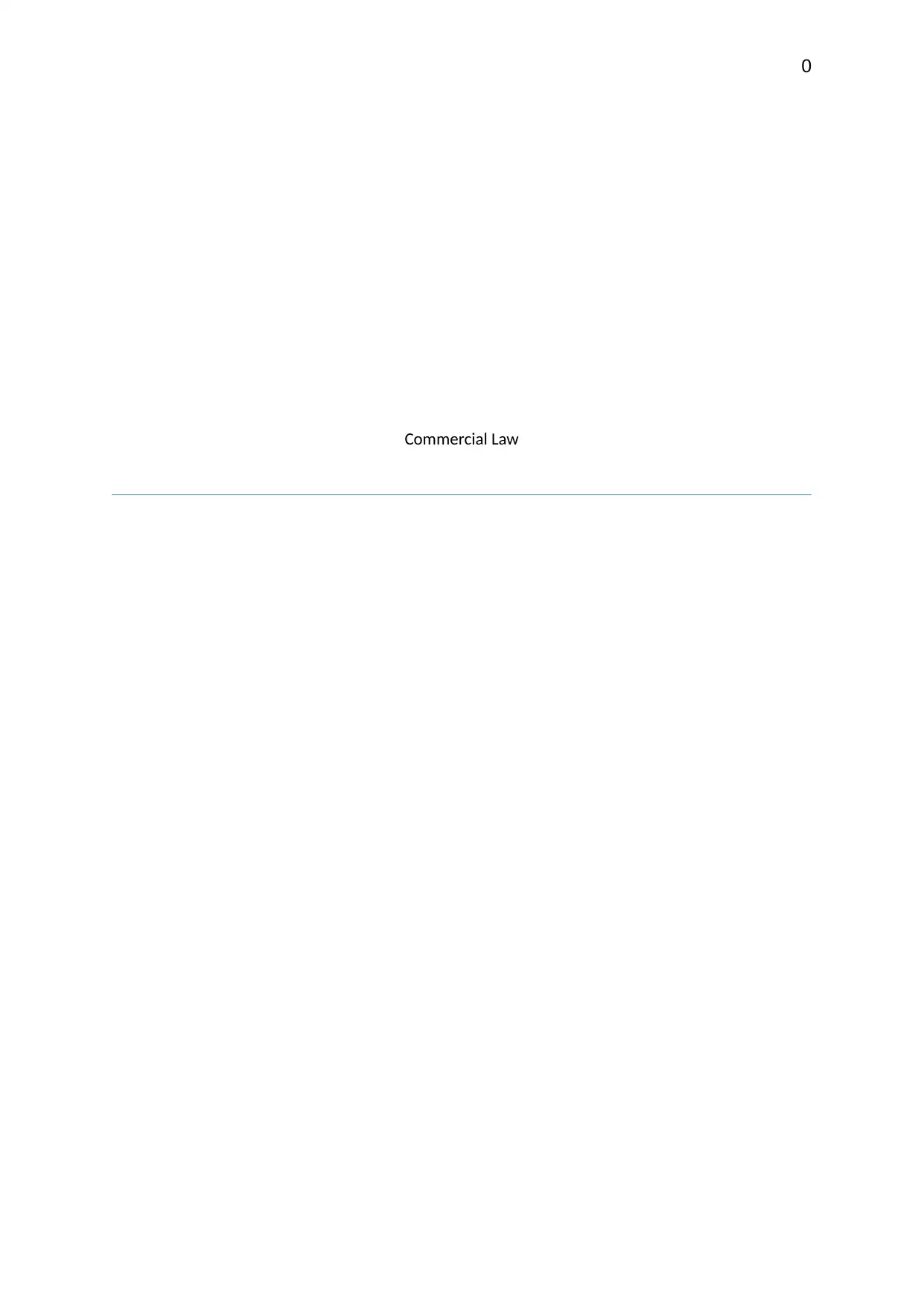
0
Commercial Law
Commercial Law
Paraphrase This Document
Need a fresh take? Get an instant paraphrase of this document with our AI Paraphraser
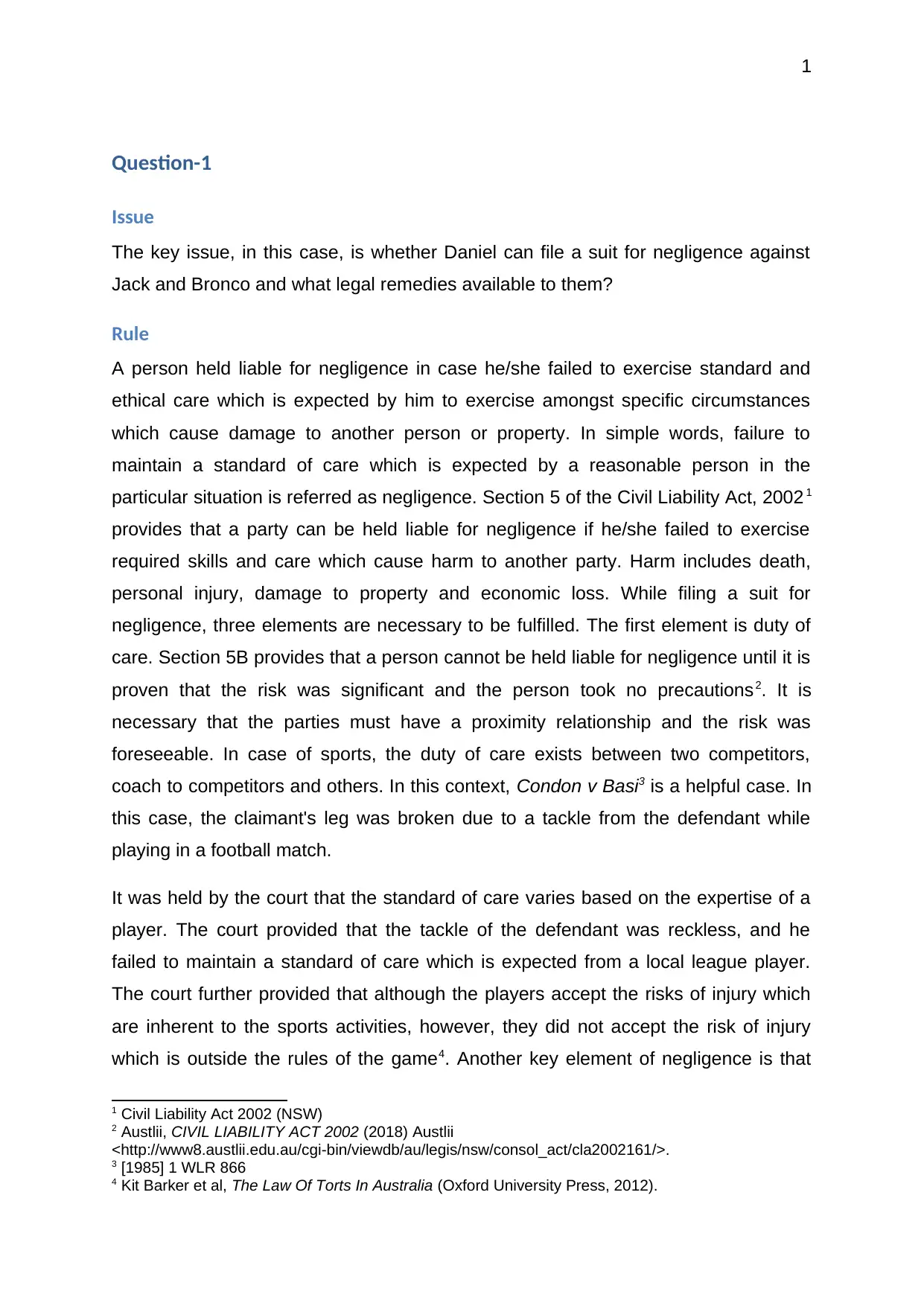
1
Question-1
Issue
The key issue, in this case, is whether Daniel can file a suit for negligence against
Jack and Bronco and what legal remedies available to them?
Rule
A person held liable for negligence in case he/she failed to exercise standard and
ethical care which is expected by him to exercise amongst specific circumstances
which cause damage to another person or property. In simple words, failure to
maintain a standard of care which is expected by a reasonable person in the
particular situation is referred as negligence. Section 5 of the Civil Liability Act, 2002 1
provides that a party can be held liable for negligence if he/she failed to exercise
required skills and care which cause harm to another party. Harm includes death,
personal injury, damage to property and economic loss. While filing a suit for
negligence, three elements are necessary to be fulfilled. The first element is duty of
care. Section 5B provides that a person cannot be held liable for negligence until it is
proven that the risk was significant and the person took no precautions2. It is
necessary that the parties must have a proximity relationship and the risk was
foreseeable. In case of sports, the duty of care exists between two competitors,
coach to competitors and others. In this context, Condon v Basi3 is a helpful case. In
this case, the claimant's leg was broken due to a tackle from the defendant while
playing in a football match.
It was held by the court that the standard of care varies based on the expertise of a
player. The court provided that the tackle of the defendant was reckless, and he
failed to maintain a standard of care which is expected from a local league player.
The court further provided that although the players accept the risks of injury which
are inherent to the sports activities, however, they did not accept the risk of injury
which is outside the rules of the game4. Another key element of negligence is that
1 Civil Liability Act 2002 (NSW)
2 Austlii, CIVIL LIABILITY ACT 2002 (2018) Austlii
<http://www8.austlii.edu.au/cgi-bin/viewdb/au/legis/nsw/consol_act/cla2002161/>.
3 [1985] 1 WLR 866
4 Kit Barker et al, The Law Of Torts In Australia (Oxford University Press, 2012).
Question-1
Issue
The key issue, in this case, is whether Daniel can file a suit for negligence against
Jack and Bronco and what legal remedies available to them?
Rule
A person held liable for negligence in case he/she failed to exercise standard and
ethical care which is expected by him to exercise amongst specific circumstances
which cause damage to another person or property. In simple words, failure to
maintain a standard of care which is expected by a reasonable person in the
particular situation is referred as negligence. Section 5 of the Civil Liability Act, 2002 1
provides that a party can be held liable for negligence if he/she failed to exercise
required skills and care which cause harm to another party. Harm includes death,
personal injury, damage to property and economic loss. While filing a suit for
negligence, three elements are necessary to be fulfilled. The first element is duty of
care. Section 5B provides that a person cannot be held liable for negligence until it is
proven that the risk was significant and the person took no precautions2. It is
necessary that the parties must have a proximity relationship and the risk was
foreseeable. In case of sports, the duty of care exists between two competitors,
coach to competitors and others. In this context, Condon v Basi3 is a helpful case. In
this case, the claimant's leg was broken due to a tackle from the defendant while
playing in a football match.
It was held by the court that the standard of care varies based on the expertise of a
player. The court provided that the tackle of the defendant was reckless, and he
failed to maintain a standard of care which is expected from a local league player.
The court further provided that although the players accept the risks of injury which
are inherent to the sports activities, however, they did not accept the risk of injury
which is outside the rules of the game4. Another key element of negligence is that
1 Civil Liability Act 2002 (NSW)
2 Austlii, CIVIL LIABILITY ACT 2002 (2018) Austlii
<http://www8.austlii.edu.au/cgi-bin/viewdb/au/legis/nsw/consol_act/cla2002161/>.
3 [1985] 1 WLR 866
4 Kit Barker et al, The Law Of Torts In Australia (Oxford University Press, 2012).
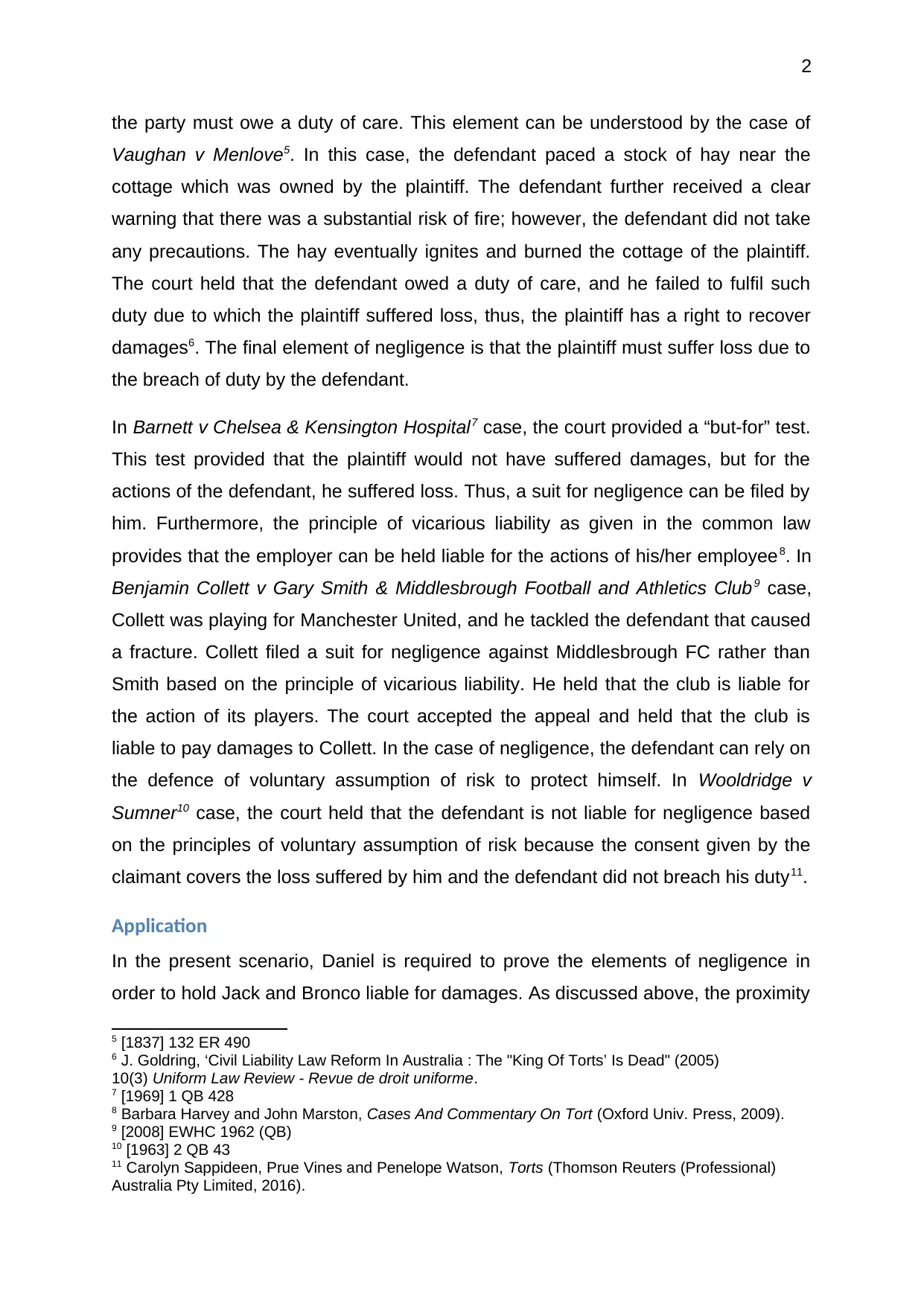
2
the party must owe a duty of care. This element can be understood by the case of
Vaughan v Menlove5. In this case, the defendant paced a stock of hay near the
cottage which was owned by the plaintiff. The defendant further received a clear
warning that there was a substantial risk of fire; however, the defendant did not take
any precautions. The hay eventually ignites and burned the cottage of the plaintiff.
The court held that the defendant owed a duty of care, and he failed to fulfil such
duty due to which the plaintiff suffered loss, thus, the plaintiff has a right to recover
damages6. The final element of negligence is that the plaintiff must suffer loss due to
the breach of duty by the defendant.
In Barnett v Chelsea & Kensington Hospital7 case, the court provided a “but-for” test.
This test provided that the plaintiff would not have suffered damages, but for the
actions of the defendant, he suffered loss. Thus, a suit for negligence can be filed by
him. Furthermore, the principle of vicarious liability as given in the common law
provides that the employer can be held liable for the actions of his/her employee8. In
Benjamin Collett v Gary Smith & Middlesbrough Football and Athletics Club9 case,
Collett was playing for Manchester United, and he tackled the defendant that caused
a fracture. Collett filed a suit for negligence against Middlesbrough FC rather than
Smith based on the principle of vicarious liability. He held that the club is liable for
the action of its players. The court accepted the appeal and held that the club is
liable to pay damages to Collett. In the case of negligence, the defendant can rely on
the defence of voluntary assumption of risk to protect himself. In Wooldridge v
Sumner10 case, the court held that the defendant is not liable for negligence based
on the principles of voluntary assumption of risk because the consent given by the
claimant covers the loss suffered by him and the defendant did not breach his duty11.
Application
In the present scenario, Daniel is required to prove the elements of negligence in
order to hold Jack and Bronco liable for damages. As discussed above, the proximity
5 [1837] 132 ER 490
6 J. Goldring, ‘Civil Liability Law Reform In Australia : The "King Of Torts’ Is Dead" (2005)
10(3) Uniform Law Review - Revue de droit uniforme.
7 [1969] 1 QB 428
8 Barbara Harvey and John Marston, Cases And Commentary On Tort (Oxford Univ. Press, 2009).
9 [2008] EWHC 1962 (QB)
10 [1963] 2 QB 43
11 Carolyn Sappideen, Prue Vines and Penelope Watson, Torts (Thomson Reuters (Professional)
Australia Pty Limited, 2016).
the party must owe a duty of care. This element can be understood by the case of
Vaughan v Menlove5. In this case, the defendant paced a stock of hay near the
cottage which was owned by the plaintiff. The defendant further received a clear
warning that there was a substantial risk of fire; however, the defendant did not take
any precautions. The hay eventually ignites and burned the cottage of the plaintiff.
The court held that the defendant owed a duty of care, and he failed to fulfil such
duty due to which the plaintiff suffered loss, thus, the plaintiff has a right to recover
damages6. The final element of negligence is that the plaintiff must suffer loss due to
the breach of duty by the defendant.
In Barnett v Chelsea & Kensington Hospital7 case, the court provided a “but-for” test.
This test provided that the plaintiff would not have suffered damages, but for the
actions of the defendant, he suffered loss. Thus, a suit for negligence can be filed by
him. Furthermore, the principle of vicarious liability as given in the common law
provides that the employer can be held liable for the actions of his/her employee8. In
Benjamin Collett v Gary Smith & Middlesbrough Football and Athletics Club9 case,
Collett was playing for Manchester United, and he tackled the defendant that caused
a fracture. Collett filed a suit for negligence against Middlesbrough FC rather than
Smith based on the principle of vicarious liability. He held that the club is liable for
the action of its players. The court accepted the appeal and held that the club is
liable to pay damages to Collett. In the case of negligence, the defendant can rely on
the defence of voluntary assumption of risk to protect himself. In Wooldridge v
Sumner10 case, the court held that the defendant is not liable for negligence based
on the principles of voluntary assumption of risk because the consent given by the
claimant covers the loss suffered by him and the defendant did not breach his duty11.
Application
In the present scenario, Daniel is required to prove the elements of negligence in
order to hold Jack and Bronco liable for damages. As discussed above, the proximity
5 [1837] 132 ER 490
6 J. Goldring, ‘Civil Liability Law Reform In Australia : The "King Of Torts’ Is Dead" (2005)
10(3) Uniform Law Review - Revue de droit uniforme.
7 [1969] 1 QB 428
8 Barbara Harvey and John Marston, Cases And Commentary On Tort (Oxford Univ. Press, 2009).
9 [2008] EWHC 1962 (QB)
10 [1963] 2 QB 43
11 Carolyn Sappideen, Prue Vines and Penelope Watson, Torts (Thomson Reuters (Professional)
Australia Pty Limited, 2016).
⊘ This is a preview!⊘
Do you want full access?
Subscribe today to unlock all pages.

Trusted by 1+ million students worldwide
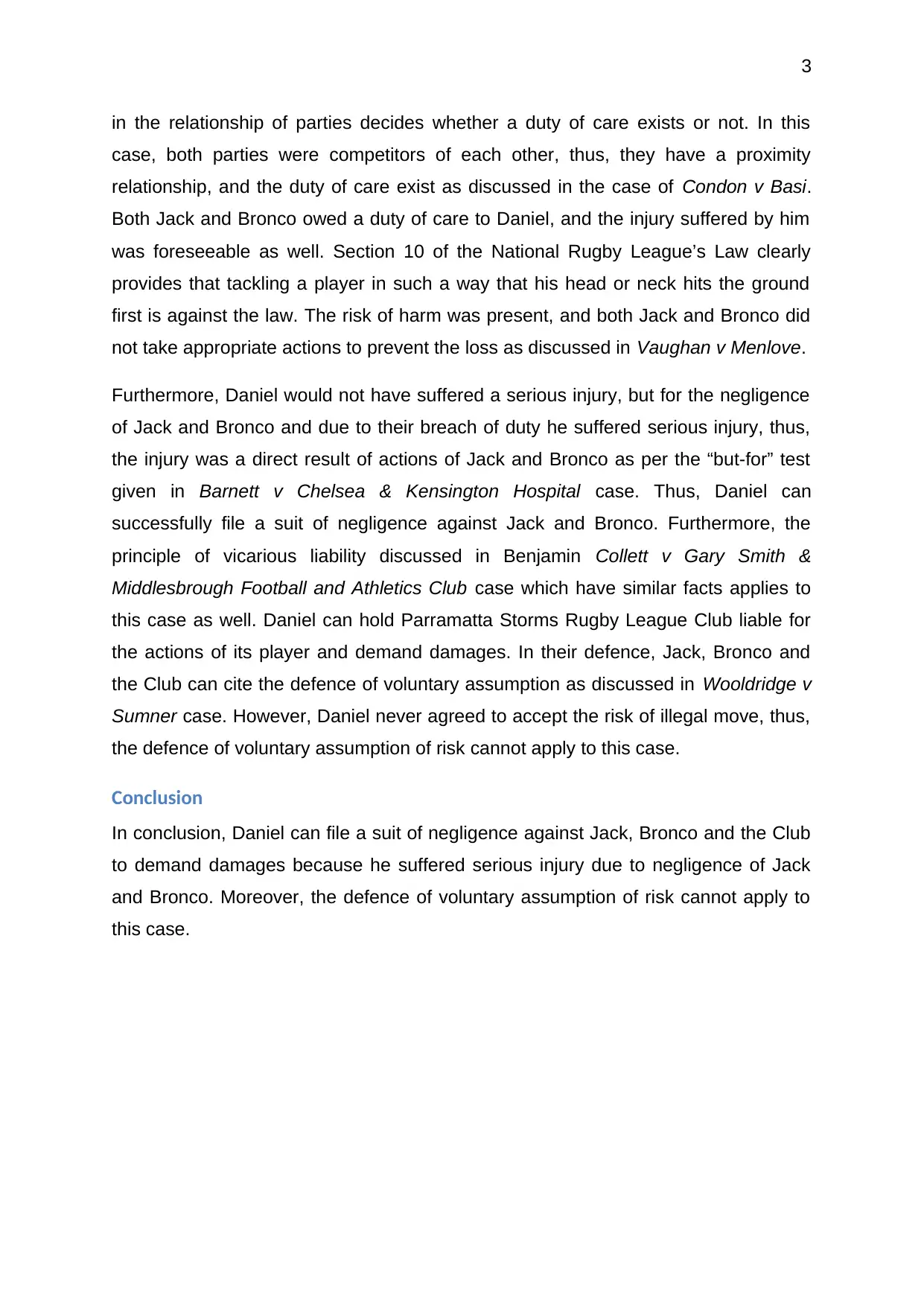
3
in the relationship of parties decides whether a duty of care exists or not. In this
case, both parties were competitors of each other, thus, they have a proximity
relationship, and the duty of care exist as discussed in the case of Condon v Basi.
Both Jack and Bronco owed a duty of care to Daniel, and the injury suffered by him
was foreseeable as well. Section 10 of the National Rugby League’s Law clearly
provides that tackling a player in such a way that his head or neck hits the ground
first is against the law. The risk of harm was present, and both Jack and Bronco did
not take appropriate actions to prevent the loss as discussed in Vaughan v Menlove.
Furthermore, Daniel would not have suffered a serious injury, but for the negligence
of Jack and Bronco and due to their breach of duty he suffered serious injury, thus,
the injury was a direct result of actions of Jack and Bronco as per the “but-for” test
given in Barnett v Chelsea & Kensington Hospital case. Thus, Daniel can
successfully file a suit of negligence against Jack and Bronco. Furthermore, the
principle of vicarious liability discussed in Benjamin Collett v Gary Smith &
Middlesbrough Football and Athletics Club case which have similar facts applies to
this case as well. Daniel can hold Parramatta Storms Rugby League Club liable for
the actions of its player and demand damages. In their defence, Jack, Bronco and
the Club can cite the defence of voluntary assumption as discussed in Wooldridge v
Sumner case. However, Daniel never agreed to accept the risk of illegal move, thus,
the defence of voluntary assumption of risk cannot apply to this case.
Conclusion
In conclusion, Daniel can file a suit of negligence against Jack, Bronco and the Club
to demand damages because he suffered serious injury due to negligence of Jack
and Bronco. Moreover, the defence of voluntary assumption of risk cannot apply to
this case.
in the relationship of parties decides whether a duty of care exists or not. In this
case, both parties were competitors of each other, thus, they have a proximity
relationship, and the duty of care exist as discussed in the case of Condon v Basi.
Both Jack and Bronco owed a duty of care to Daniel, and the injury suffered by him
was foreseeable as well. Section 10 of the National Rugby League’s Law clearly
provides that tackling a player in such a way that his head or neck hits the ground
first is against the law. The risk of harm was present, and both Jack and Bronco did
not take appropriate actions to prevent the loss as discussed in Vaughan v Menlove.
Furthermore, Daniel would not have suffered a serious injury, but for the negligence
of Jack and Bronco and due to their breach of duty he suffered serious injury, thus,
the injury was a direct result of actions of Jack and Bronco as per the “but-for” test
given in Barnett v Chelsea & Kensington Hospital case. Thus, Daniel can
successfully file a suit of negligence against Jack and Bronco. Furthermore, the
principle of vicarious liability discussed in Benjamin Collett v Gary Smith &
Middlesbrough Football and Athletics Club case which have similar facts applies to
this case as well. Daniel can hold Parramatta Storms Rugby League Club liable for
the actions of its player and demand damages. In their defence, Jack, Bronco and
the Club can cite the defence of voluntary assumption as discussed in Wooldridge v
Sumner case. However, Daniel never agreed to accept the risk of illegal move, thus,
the defence of voluntary assumption of risk cannot apply to this case.
Conclusion
In conclusion, Daniel can file a suit of negligence against Jack, Bronco and the Club
to demand damages because he suffered serious injury due to negligence of Jack
and Bronco. Moreover, the defence of voluntary assumption of risk cannot apply to
this case.
Paraphrase This Document
Need a fresh take? Get an instant paraphrase of this document with our AI Paraphraser
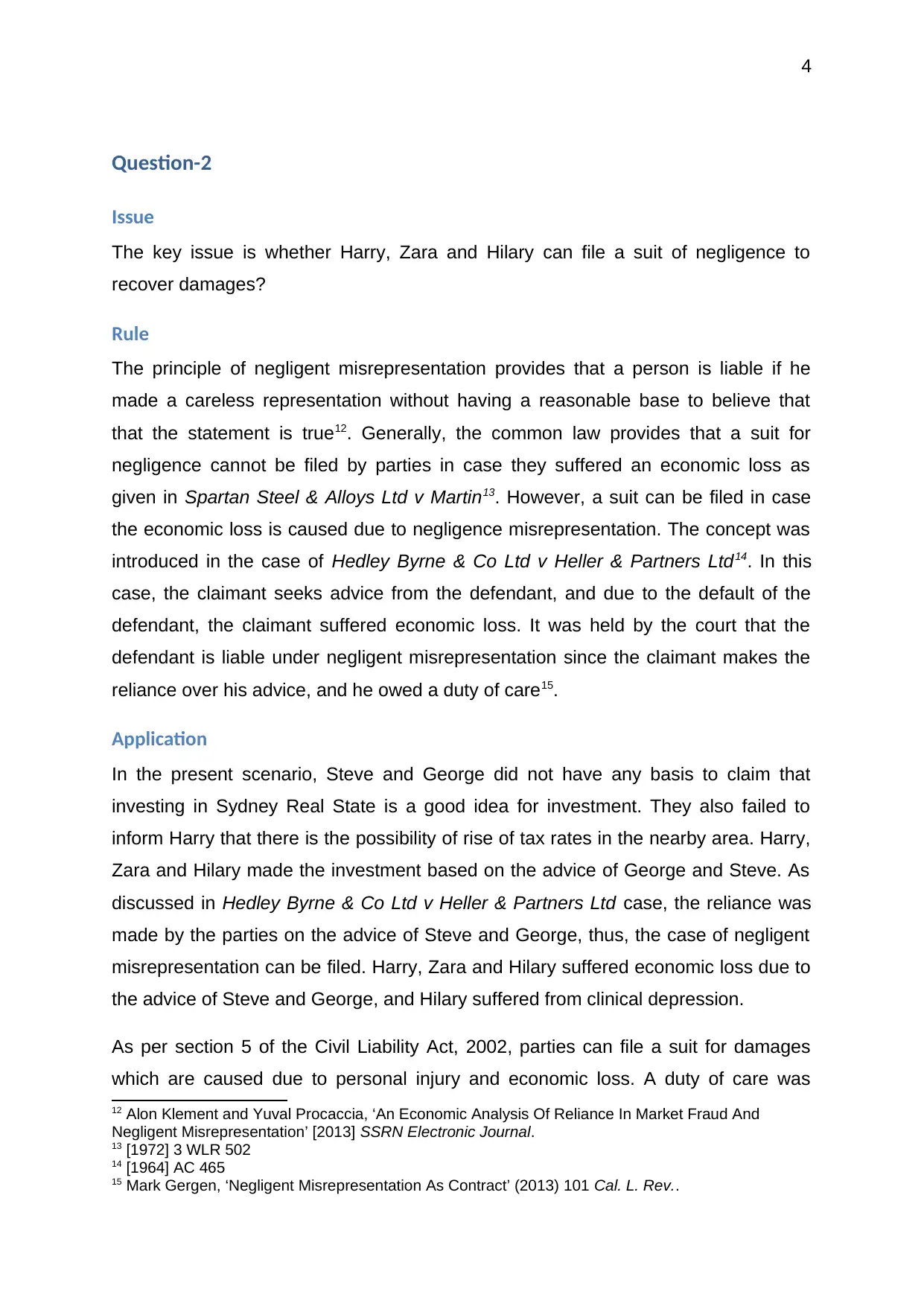
4
Question-2
Issue
The key issue is whether Harry, Zara and Hilary can file a suit of negligence to
recover damages?
Rule
The principle of negligent misrepresentation provides that a person is liable if he
made a careless representation without having a reasonable base to believe that
that the statement is true12. Generally, the common law provides that a suit for
negligence cannot be filed by parties in case they suffered an economic loss as
given in Spartan Steel & Alloys Ltd v Martin13. However, a suit can be filed in case
the economic loss is caused due to negligence misrepresentation. The concept was
introduced in the case of Hedley Byrne & Co Ltd v Heller & Partners Ltd14. In this
case, the claimant seeks advice from the defendant, and due to the default of the
defendant, the claimant suffered economic loss. It was held by the court that the
defendant is liable under negligent misrepresentation since the claimant makes the
reliance over his advice, and he owed a duty of care15.
Application
In the present scenario, Steve and George did not have any basis to claim that
investing in Sydney Real State is a good idea for investment. They also failed to
inform Harry that there is the possibility of rise of tax rates in the nearby area. Harry,
Zara and Hilary made the investment based on the advice of George and Steve. As
discussed in Hedley Byrne & Co Ltd v Heller & Partners Ltd case, the reliance was
made by the parties on the advice of Steve and George, thus, the case of negligent
misrepresentation can be filed. Harry, Zara and Hilary suffered economic loss due to
the advice of Steve and George, and Hilary suffered from clinical depression.
As per section 5 of the Civil Liability Act, 2002, parties can file a suit for damages
which are caused due to personal injury and economic loss. A duty of care was
12 Alon Klement and Yuval Procaccia, ‘An Economic Analysis Of Reliance In Market Fraud And
Negligent Misrepresentation’ [2013] SSRN Electronic Journal.
13 [1972] 3 WLR 502
14 [1964] AC 465
15 Mark Gergen, ‘Negligent Misrepresentation As Contract’ (2013) 101 Cal. L. Rev..
Question-2
Issue
The key issue is whether Harry, Zara and Hilary can file a suit of negligence to
recover damages?
Rule
The principle of negligent misrepresentation provides that a person is liable if he
made a careless representation without having a reasonable base to believe that
that the statement is true12. Generally, the common law provides that a suit for
negligence cannot be filed by parties in case they suffered an economic loss as
given in Spartan Steel & Alloys Ltd v Martin13. However, a suit can be filed in case
the economic loss is caused due to negligence misrepresentation. The concept was
introduced in the case of Hedley Byrne & Co Ltd v Heller & Partners Ltd14. In this
case, the claimant seeks advice from the defendant, and due to the default of the
defendant, the claimant suffered economic loss. It was held by the court that the
defendant is liable under negligent misrepresentation since the claimant makes the
reliance over his advice, and he owed a duty of care15.
Application
In the present scenario, Steve and George did not have any basis to claim that
investing in Sydney Real State is a good idea for investment. They also failed to
inform Harry that there is the possibility of rise of tax rates in the nearby area. Harry,
Zara and Hilary made the investment based on the advice of George and Steve. As
discussed in Hedley Byrne & Co Ltd v Heller & Partners Ltd case, the reliance was
made by the parties on the advice of Steve and George, thus, the case of negligent
misrepresentation can be filed. Harry, Zara and Hilary suffered economic loss due to
the advice of Steve and George, and Hilary suffered from clinical depression.
As per section 5 of the Civil Liability Act, 2002, parties can file a suit for damages
which are caused due to personal injury and economic loss. A duty of care was
12 Alon Klement and Yuval Procaccia, ‘An Economic Analysis Of Reliance In Market Fraud And
Negligent Misrepresentation’ [2013] SSRN Electronic Journal.
13 [1972] 3 WLR 502
14 [1964] AC 465
15 Mark Gergen, ‘Negligent Misrepresentation As Contract’ (2013) 101 Cal. L. Rev..
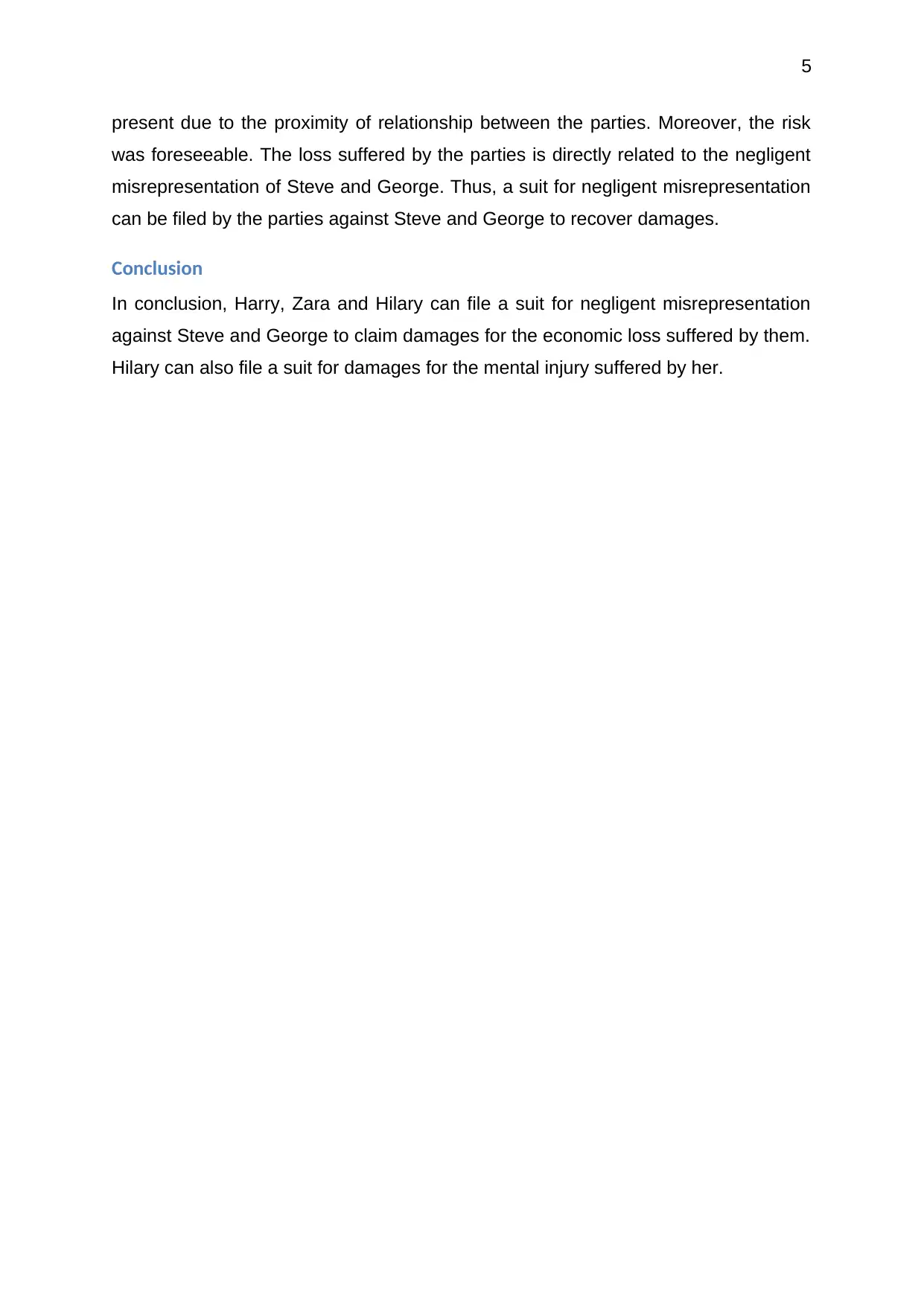
5
present due to the proximity of relationship between the parties. Moreover, the risk
was foreseeable. The loss suffered by the parties is directly related to the negligent
misrepresentation of Steve and George. Thus, a suit for negligent misrepresentation
can be filed by the parties against Steve and George to recover damages.
Conclusion
In conclusion, Harry, Zara and Hilary can file a suit for negligent misrepresentation
against Steve and George to claim damages for the economic loss suffered by them.
Hilary can also file a suit for damages for the mental injury suffered by her.
present due to the proximity of relationship between the parties. Moreover, the risk
was foreseeable. The loss suffered by the parties is directly related to the negligent
misrepresentation of Steve and George. Thus, a suit for negligent misrepresentation
can be filed by the parties against Steve and George to recover damages.
Conclusion
In conclusion, Harry, Zara and Hilary can file a suit for negligent misrepresentation
against Steve and George to claim damages for the economic loss suffered by them.
Hilary can also file a suit for damages for the mental injury suffered by her.
⊘ This is a preview!⊘
Do you want full access?
Subscribe today to unlock all pages.

Trusted by 1+ million students worldwide
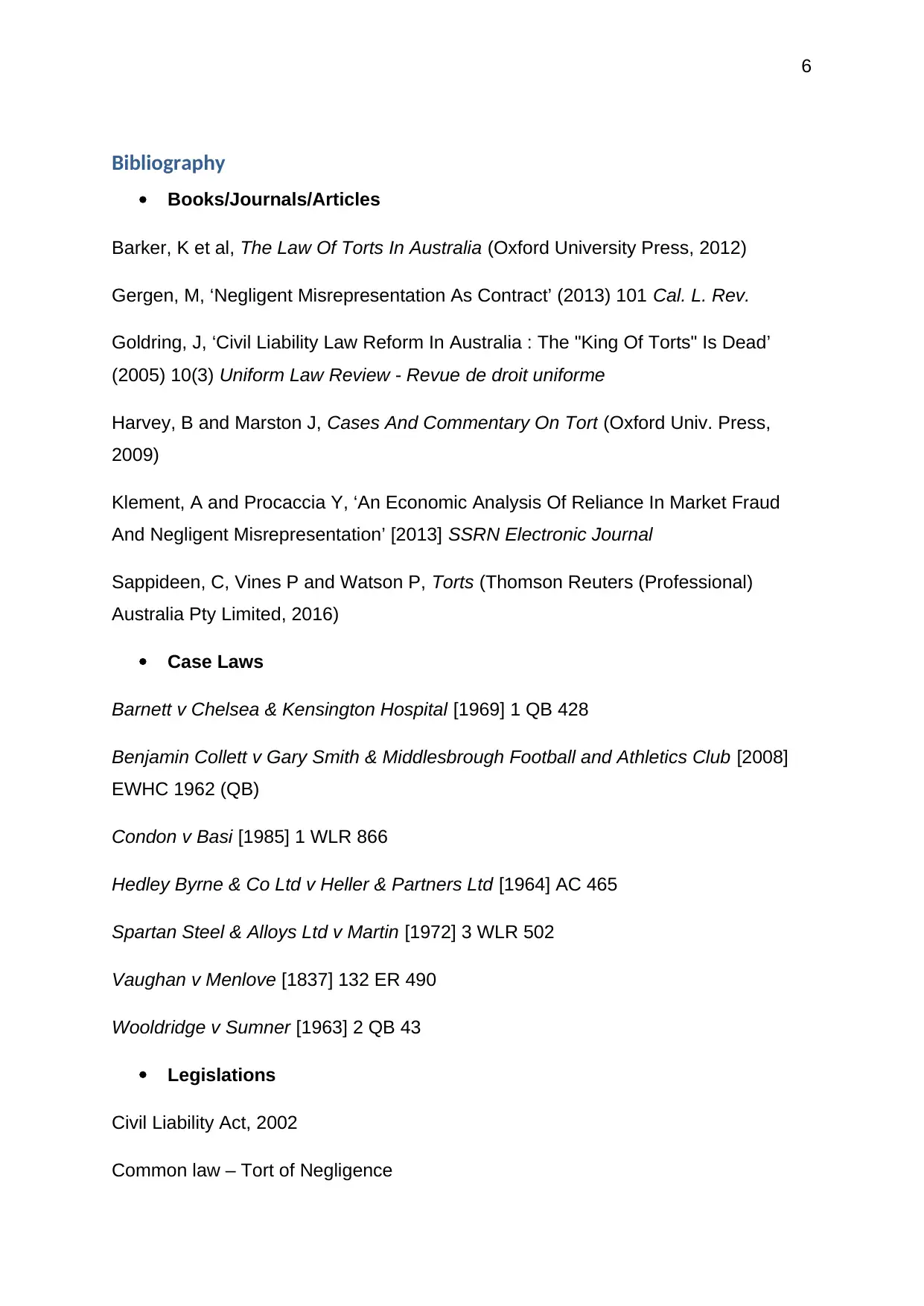
6
Bibliography
Books/Journals/Articles
Barker, K et al, The Law Of Torts In Australia (Oxford University Press, 2012)
Gergen, M, ‘Negligent Misrepresentation As Contract’ (2013) 101 Cal. L. Rev.
Goldring, J, ‘Civil Liability Law Reform In Australia : The "King Of Torts" Is Dead’
(2005) 10(3) Uniform Law Review - Revue de droit uniforme
Harvey, B and Marston J, Cases And Commentary On Tort (Oxford Univ. Press,
2009)
Klement, A and Procaccia Y, ‘An Economic Analysis Of Reliance In Market Fraud
And Negligent Misrepresentation’ [2013] SSRN Electronic Journal
Sappideen, C, Vines P and Watson P, Torts (Thomson Reuters (Professional)
Australia Pty Limited, 2016)
Case Laws
Barnett v Chelsea & Kensington Hospital [1969] 1 QB 428
Benjamin Collett v Gary Smith & Middlesbrough Football and Athletics Club [2008]
EWHC 1962 (QB)
Condon v Basi [1985] 1 WLR 866
Hedley Byrne & Co Ltd v Heller & Partners Ltd [1964] AC 465
Spartan Steel & Alloys Ltd v Martin [1972] 3 WLR 502
Vaughan v Menlove [1837] 132 ER 490
Wooldridge v Sumner [1963] 2 QB 43
Legislations
Civil Liability Act, 2002
Common law – Tort of Negligence
Bibliography
Books/Journals/Articles
Barker, K et al, The Law Of Torts In Australia (Oxford University Press, 2012)
Gergen, M, ‘Negligent Misrepresentation As Contract’ (2013) 101 Cal. L. Rev.
Goldring, J, ‘Civil Liability Law Reform In Australia : The "King Of Torts" Is Dead’
(2005) 10(3) Uniform Law Review - Revue de droit uniforme
Harvey, B and Marston J, Cases And Commentary On Tort (Oxford Univ. Press,
2009)
Klement, A and Procaccia Y, ‘An Economic Analysis Of Reliance In Market Fraud
And Negligent Misrepresentation’ [2013] SSRN Electronic Journal
Sappideen, C, Vines P and Watson P, Torts (Thomson Reuters (Professional)
Australia Pty Limited, 2016)
Case Laws
Barnett v Chelsea & Kensington Hospital [1969] 1 QB 428
Benjamin Collett v Gary Smith & Middlesbrough Football and Athletics Club [2008]
EWHC 1962 (QB)
Condon v Basi [1985] 1 WLR 866
Hedley Byrne & Co Ltd v Heller & Partners Ltd [1964] AC 465
Spartan Steel & Alloys Ltd v Martin [1972] 3 WLR 502
Vaughan v Menlove [1837] 132 ER 490
Wooldridge v Sumner [1963] 2 QB 43
Legislations
Civil Liability Act, 2002
Common law – Tort of Negligence
Paraphrase This Document
Need a fresh take? Get an instant paraphrase of this document with our AI Paraphraser
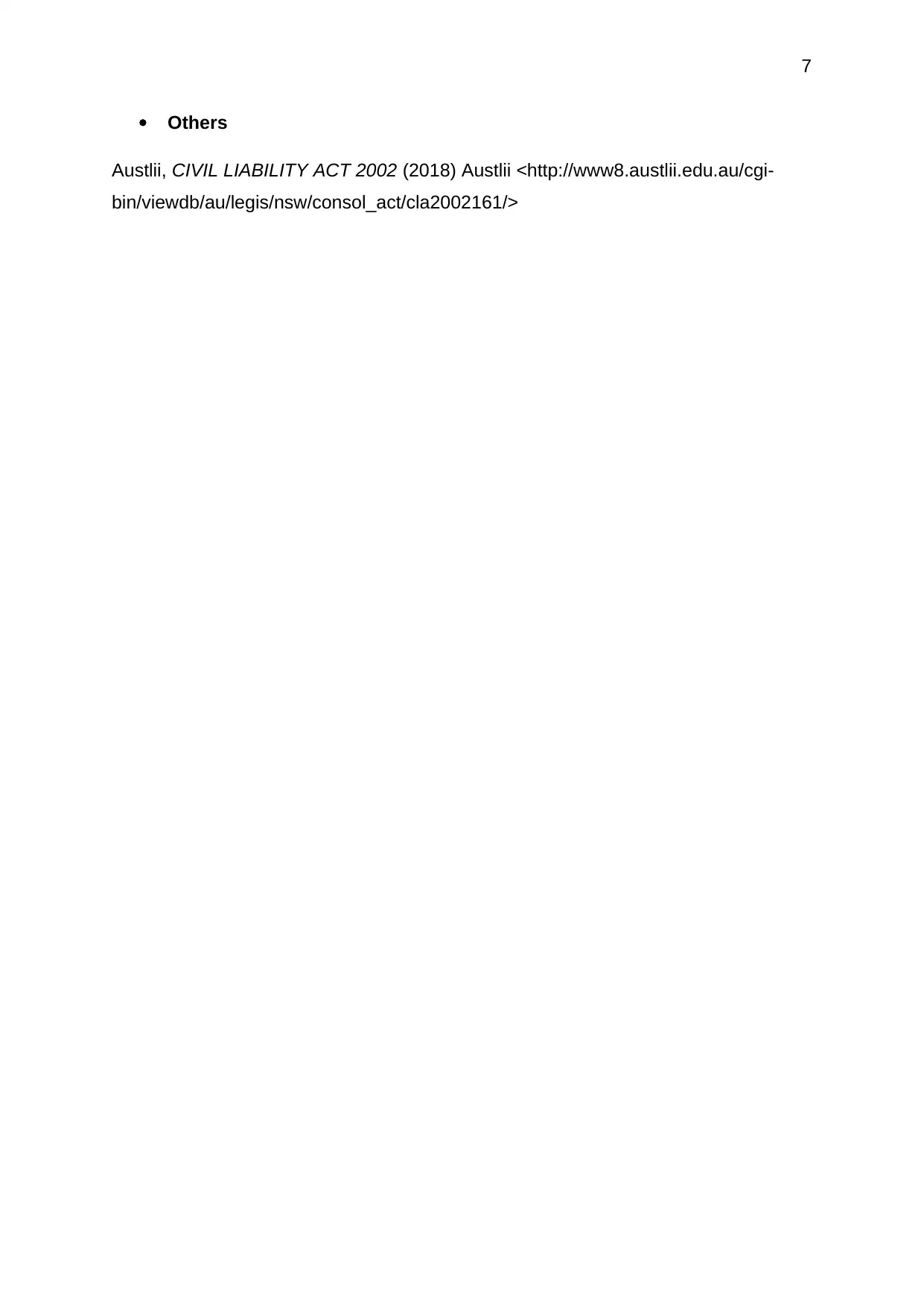
7
Others
Austlii, CIVIL LIABILITY ACT 2002 (2018) Austlii <http://www8.austlii.edu.au/cgi-
bin/viewdb/au/legis/nsw/consol_act/cla2002161/>
Others
Austlii, CIVIL LIABILITY ACT 2002 (2018) Austlii <http://www8.austlii.edu.au/cgi-
bin/viewdb/au/legis/nsw/consol_act/cla2002161/>
1 out of 8
Related Documents
Your All-in-One AI-Powered Toolkit for Academic Success.
+13062052269
info@desklib.com
Available 24*7 on WhatsApp / Email
![[object Object]](/_next/static/media/star-bottom.7253800d.svg)
Unlock your academic potential
Copyright © 2020–2025 A2Z Services. All Rights Reserved. Developed and managed by ZUCOL.





